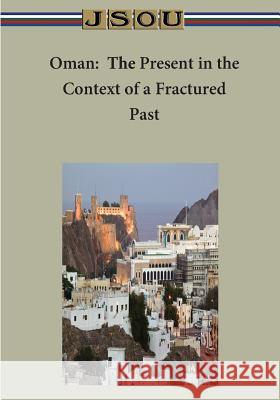Oman: The Present in the Context of a Fractured Past » książka
Oman: The Present in the Context of a Fractured Past
ISBN-13: 9781500877545 / Angielski / Miękka / 2014 / 100 str.
The Sultanate of Oman is a key member of the Gulf Cooperation Council and ally of the West located on the strategically critical Straits of Hormuz at the entrance to the Arabian Gulf. Contrasting sharply with its tumultuous past, its political experience of the last 40 years is often offered as a model of successful social, economic, and political development and stability. Oman is an example of how lines on a map emerge as a stable, unified nation. In addition, the ultimate success of Sultan Qaboos bin Taimur al-Sa'id (1970- present) in defeating the Dhofar insurgency in the 1970s is widely regarded as a model for counterinsurgency operations. The subsequent infrastructure and economic investment in Oman in general and in Dhofar in particular are cited as successful examples of using development as a compliment to military operations, thus removing the oxygen on which the insurgency thrived. These views are absolutely correct with regard to the last 40 years, but as recent Middle East events have demonstrated, political and cultural myopia can result in distorted analysis, which in turn can lead to unpleasant surprises. Placing too much weight on contemporary events, in this case the last 50 years, in a region where that is a historical blink of the eye can be problematic. From a policy perspective, the contemporary period, the exception, becomes the rule on which planning and strategy are based, often putting both at risk. This short-term Western view of the past and "progress" is in sharp contrast to that of Middle Eastern cultures that define themselves based on interpretations of events that happened millennia in the past. It is difficult for outsiders to fully comprehend that the principal tie in a society is to family, clan, tribe, and region above all else and that political, economic, social, and cultural development underlie these ties. 1 A few decades of development and stability usually only provide a superficial facade behind which the old attitudes and culture are still alive and well. As a result, in the critical caldron that is the contemporary Middle East, policy at times focuses on the facade without a proper appreciation for the extremely complex political, economic, and cultural milieu behind it. The principal focus of this study is to ask that very question - in the case of a critical ally in the Arabian Gulf community: are Oman's Western allies focused on the facade or the more complex reality behind it? Is it possible that there could be a series of unpleasant surprises in store and might a more in-depth look enable the West to anticipate the unexpected and support an ally better while protecting its own interests at the same time? This study is designed to provide a snapshot of one of the more complex states of the Arabian Gulf - Oman, an introduction to the complexities that must first be understood before any other strategies and contingencies can possibly be developed. In the Middle East, there is no such thing as a one-size-fits-all strategy, plan, or operations concept - at least not an effective one."












